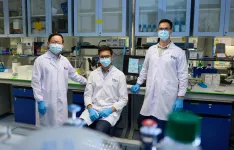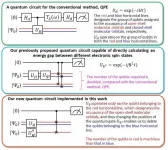It's snowing plastic
New technique detects minute particles of plastics in snow, rain and even soil
2021-03-17
(Press-News.org) The snow may be melting, but it is leaving pollution behind in the form of micro- and nano-plastics according to a McGill study that was recently published in Environmental Pollution. The pollution is largely due to the relatively soluble plastics found in antifreeze products (polyethylene glycols) that can become airborne and picked up by the snow.
The researchers used a new technique that they have developed to analyze snow samples collected in April 2019 in Montreal for both micro- and nano-sized particles of various plastics. The McGill technique is orders of magnitude more sensitive than any of the other current methods used for tracing plastic in the environment. It allows scientists to detect ultra-trace quantities of many of the most common soluble and insoluble plastics in snow, water, rainfall, and even in soil samples once they have been separated - down to the level of a picogram (or one trillionth of a gram). It is based on using nano-structured mass spectrometry and, unlike other techniques currently in use, the new technique is both recyclable and based on sustainable practices.
"It is important to be able to detect even trace quantities of plastics in the environment," says senior author, Parisa Ariya, from McGill's Departments of Chemistry and Atmospheric and Oceanic Sciences. "Though these plastics may be harmless in themselves, they can pick up toxic organic matter and heavy metals from the environment, which can damage human cells and organs."
The first author, Zi Wang, a PhD Candidate at McGill adds, "Our hope is that this new technique can be used by scientists in different domains gain key information about the quantity of micro- and nano-plastics in urban environments in order to better address their impacts on the ecosystem and on human health."
INFORMATION:
To read: "Advances in Ultra-Trace Analytical Capability for Micro/Nanoplastics and Water-Soluble Polymers in the Environment: Fresh Falling Urban Snow", by Zi Wang, Nadim K. Saadé, and Parisa A. Ariya in Environmental Pollution.
https://doi.org/10.1016/j.envpol.2021.116698
The research was funded by the Natural Science and Engineering Research Council of Canada (NSERC), National Research Council Canada (NRC) and Environment of Climate Change Canada (ECCC).
About McGill University
Founded in Montreal, Quebec, in 1821, McGill University is Canada's top ranked medical doctoral university. McGill is consistently ranked as one of the top universities, both nationally and internationally. It is a world-renowned institution of higher learning with research activities spanning two campuses, 11 faculties, 13 professional schools, 300 programs of study and over 40,000 students, including more than 10,200 graduate students. McGill attracts students from over 150 countries around the world, its 12,800 international students making up 31% of the student body. Over half of McGill students claim a first language other than English, including approximately 19% of our students who say French is their mother tongue.
Contact:
Katherine Gombay
McGill Media Relations Office
1-514-717-2289
katherine.gombay@mcgill.ca
http://www.mcgill.ca/newsroom/
http://twitter.com/McGillU
ELSE PRESS RELEASES FROM THIS DATE:
2021-03-17
Researchers at Rutgers School of Dental Medicine have found evidence that two types of mouthwash disrupt the COVID-19 virus under laboratory conditions, preventing it from replicating in a human cell.
The study, published in the journal Pathogens, found that Listerine and the prescription mouthwash Chlorhexidine disrupted the virus within seconds after being diluted to concentrations that would mimic actual use. Further studies are needed to test real-life efficacy in humans.
The study was conducted in a lab using concentrations of the mouthwash ...
2021-03-17
A study published March 16 in JAMA (the Journal of the American Medical Association) confirms that neither vitamin D nor the omega-3 fatty acids found in fish oil prevent the development of atrial fibrillation (AF), a potentially serious heart rhythm disturbance. The newly published research follows a presentation made by Christine Albert, MD, MPH, at the American Heart Association Scientific Sessions last year.
In their JAMA analysis, Albert and her research team also examined whether vitamin D or omega-3 fatty acids might have an impact on paroxysmal versus persistent atrial ...
2021-03-17
Millimetre and terahertz wave detectors have a wide range of applications in areas such as communications, security, biological diagnosis, spectroscopy, and remote sensing. They are the components that can transform light information loaded by long-wavelength millimetre and terahertz waves into electrical signals. High-performance room-temperature detectors with high sensitivity, fast response, broad spectral bandwidth, and possibility to be extended to large format arrays are always pursued. They are the building blocks for a wide range of millimetre ...
2021-03-17
Singapore, 17 March 2021 - Healthy and cancer cells can look similar under a microscope. One way of differentiating them is by examining the level of acidity, or pH level, inside the cells.
Tapping on this distinguishing characteristic, a research team from the National University of Singapore (NUS) has developed a technique that uses artificial intelligence (AI) to determine whether a single cell is healthy or cancerous by analysing its pH. Each cancer test can be completed in under 35 minutes, and single cells can be classified with an accuracy rate of more than 95 per cent.
The research, led by Professor Lim Chwee Teck, Director of the Institute for Health Innovation ...
2021-03-17
A 2020 explosion in Lebanon's port city of Beirut led to a southward-bound, high-velocity atmospheric wave that rivaled ones generated by volcanic eruptions.
Just after 6 p.m. local time (15.00 UTC) on August 4, 2020, more than 2,750 tons worth of unsafely stored ammonium nitrate exploded in Lebanon's port city of Beirut, killing around 200 people, making more than 300,000 temporarily homeless, and leaving a 140-metre-diameter crater in its wake. The blast is considered one of the most powerful non-nuclear, man-made explosions in human history.
Now, calculations by Hokkaido University scientists in Japan have found that the atmospheric ...
2021-03-17
PHILADEPHIA - Since the 1990s the rate of spinal fusion to treat lower back pain has been on the rise. A new prospective clinical study published in the journal Neurosurgery, the official journal of the Congress of Neurological Surgeons, found that lumbar fusions were three times more likely to be effective and obtain better patient outcomes, when guidelines for fusion were followed. The results suggest that when surgeons operate outside of what the evidence based literature suggests, patients may not have significant improvements in their quality of life and could have increased pain or other limitations.
"Unfortunately, we don't know how many lumbar fusion surgeries are ...
2021-03-17
Philadelphia, March 17, 2021 - Researchers from Children's Hospital of Philadelphia (CHOP) affiliated with the CHOP Epilepsy Neurogenetics Initiative (ENGIN) have compiled a complete genetic and clinical analysis of more than 400 individuals with SCN2A-related disorder, which has been linked to a variety of neurodevelopmental disorders, including epilepsy and autism. By linking clinical features to genetic abnormalities in a standardized format, the researchers hope their findings lead to improved identification and clinical intervention.
The study was published ...
2021-03-17
A groundbreaking study has given new insights into how copper deposit-forming fluids are transported naturally from their source deep underground towards the Earth's surface.
A team of geologists, led by Lawrence Carter from the University of Exeter's Camborne School of Mines, has published a new theory for how porphyry copper deposits form.
Porphyry deposits provide around 75 per cent of the world's copper which is in increasing demand for electric vehicles, power infrastructure and green technologies such as wind turbines. They originally develop several kilometres below the Earth's surface above large magma chambers. Not only are porphyry deposits rare but most large near-surface examples have already been ...
2021-03-17
A world-first 'flow model' devised by Australian researchers could drastically slash public transport commuter times during peak periods on some of the busiest roads in major cities, new research shows.
When this flow model was implemented to improve the worst traffic bottlenecks across Melbourne, commuters saved close to 2000 hours of travel time during a single morning peak period (7am-9am) and approximately 11,000 hours of passenger travel time during a normal weekday.
Ameliorating major traffic bottlenecks also contributed to a more than 23 per cent improvement in reliability of Melbourne's public transport network, ...
2021-03-17
OSAKA, Japan. Quantum computers have seen a lot attention recently as they are expected to solve certain problems that are outside the capabilities of normal computers. Primary to these problems is determining the electronic states of atoms and molecules so they can be used more effectively in a variety of industries - from lithium-ion battery designs to in silico technologies in drug development. A common way scientists have approached this problem is by calculating the total energies of the individual states of a molecule or atom and then determine the difference in energy between these states. In nature, many molecules grow in size and complexity, and the cost to calculate this constant flux is beyond the capability of any traditional ...
LAST 30 PRESS RELEASES:
[Press-News.org] It's snowing plastic
New technique detects minute particles of plastics in snow, rain and even soil



